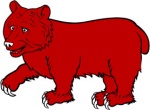Bear: Difference between revisions
No edit summary |
|||
| (3 intermediate revisions by 3 users not shown) | |||
| Line 1: | Line 1: | ||
[[Image:Bear Passant.jpg|right|150px]] |
[[Image:Bear Passant.jpg|right|150px]] |
||
'''Bears''' are quadruped mammals, of the family ''Ursidae''. They are carnivores as opposed to herbivores, but in practice will eat anything nutritious |
'''Bears''' are quadruped mammals, of the family ''Ursidae''. They are carnivores as opposed to herbivores, but in practice will eat anything nutritious. |
||
* Male: boar |
|||
* Female: dam |
|||
* Juvenile: cub |
|||
* Collective noun: sleuth |
|||
According to [[wikipedia|Wikipaedia]]:<br> |
According to [[wikipedia|Wikipaedia]]:<br> |
||
:"Common characteristics of bears include a short tail, excellent senses of smell and hearing, five un-retractable claws, and long, dense, shaggy fur. |
:"Common characteristics of bears include a short tail, excellent senses of smell and hearing, five un-retractable claws, and long, dense, shaggy fur. |
||
:"Bears have a large body with powerful limbs. They are capable of standing up on their hind legs. They have broad |
:"Bears have a large body with powerful limbs. They are capable of standing up on their hind legs. They have broad paws, long snouts, and round ears. Their teeth are used for defense and tools and depend on the diet of the bear. Their claws are used for ripping, digging, and catching." |
||
In [[period]], in [[Europe]], the principal bear was the brown bear, which was, throughout period, slowly being driven back into ever-more restricted ranges, having formerly inhabited the continent widely. [[Men|Man]] hunted the bear, with [[dog]]s, both to reduce its predations on their [[farming|cultivated]] lands, and also for [[meat]] and [[fur]]. |
In [[period]], in [[Europe]], the principal bear was the brown bear, which was, throughout period, slowly being driven back into ever-more restricted ranges, having formerly inhabited the continent widely. [[Men|Man]] hunted the bear, with [[dog]]s, both to reduce its predations on their [[farming|cultivated]] lands, and also for [[meat]] and [[fur]]. |
||
There is some evidence for bear-[[worship]] prior to period, and several [[city|cities]] (most notably Berne and Berlin) appear to have been named in commemoration of the beast. The [[Latin]] ''ursus'' links to the [[Greek]] ''arktos'' and the [[Celtic]] ''artos/arthus'', to offer one rationale for the name Arthur for a legendary warleader (''qv'' [[King Arthur]]). |
There is some evidence for bear-[[worship]] prior to period, and several [[city|cities]] (most notably Berne and Berlin) appear to have been named in commemoration of the beast. The [[Latin]] ''ursus'' links to the [[Greek]] ''arktos'' and the [[Celtic]] ''artos/arthus'', to offer one rationale for the name Arthur for a legendary warleader (''qv'' [[King Arthur]]). |
||
Regrettably the stuffed bear (''Ursus refertus'') has left no imprint upon [[medieval]] history, but it is almost inevitable that there will have been some, given that they have survived, relatively unchanged (and with very wide ranges), to the modern era. |
|||
== Bears in the SCA == |
== Bears in the SCA == |
||
The [[Barony of Septentria]] in [[Ealdormere]] has a bear [[argent]] on its arms, and a great deal of ursine symbolism is common in the [[heraldry]] and ceremony of the Barony. It was officially established by [[Fionnadh Averylle O'Connor of Maidenhead]] that the generative organs of the Septentrian Bear are correctly to be tinctured [[azure]]. |
|||
So far as is known, no bears have sought to join the SCA. Were any to do so, it is likely that they would face certain difficulties in interacting with other members. |
|||
Bears cannot [[College of Arms|register]] [[names]] or [[device]]s, nor can they become members. |
|||
The bear (or various parts of a bear) is not an uncommon [[charge]] in SCA heraldry. |
|||
==See Also== |
==See Also== |
||
Latest revision as of 07:58, 8 September 2008
Bears are quadruped mammals, of the family Ursidae. They are carnivores as opposed to herbivores, but in practice will eat anything nutritious.
- Male: boar
- Female: dam
- Juvenile: cub
- Collective noun: sleuth
According to Wikipaedia:
- "Common characteristics of bears include a short tail, excellent senses of smell and hearing, five un-retractable claws, and long, dense, shaggy fur.
- "Bears have a large body with powerful limbs. They are capable of standing up on their hind legs. They have broad paws, long snouts, and round ears. Their teeth are used for defense and tools and depend on the diet of the bear. Their claws are used for ripping, digging, and catching."
In period, in Europe, the principal bear was the brown bear, which was, throughout period, slowly being driven back into ever-more restricted ranges, having formerly inhabited the continent widely. Man hunted the bear, with dogs, both to reduce its predations on their cultivated lands, and also for meat and fur.
There is some evidence for bear-worship prior to period, and several cities (most notably Berne and Berlin) appear to have been named in commemoration of the beast. The Latin ursus links to the Greek arktos and the Celtic artos/arthus, to offer one rationale for the name Arthur for a legendary warleader (qv King Arthur).
Bears in the SCA
The Barony of Septentria in Ealdormere has a bear argent on its arms, and a great deal of ursine symbolism is common in the heraldry and ceremony of the Barony. It was officially established by Fionnadh Averylle O'Connor of Maidenhead that the generative organs of the Septentrian Bear are correctly to be tinctured azure.
The bear (or various parts of a bear) is not an uncommon charge in SCA heraldry.
